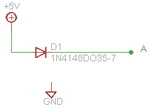vinodquilon
Full Member level 3
Consider the circuit arrangement shown in the attachment.
If I connect a MM in voltmeter mode at floating terminal A, What would be the reading on the voltmeter?
If I terminate the floating A terminal with a 10K resistor to GND, What would be the change in reading shown?
If I connect a MM in voltmeter mode at floating terminal A, What would be the reading on the voltmeter?
If I terminate the floating A terminal with a 10K resistor to GND, What would be the change in reading shown?
